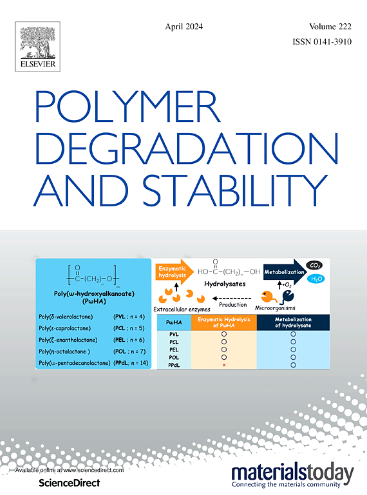Engineering sulfonated carbon black for flame-retardant and smoke-suppressive polycarbonate with well-preserved mechanical performances
IF 6.3
2区 化学
Q1 POLYMER SCIENCE
引用次数: 0
Abstract
To cope with the practical demands of high-performance polycarbonate (PC) and explore the application of carbon black (CB) in flame retardant field, a sulfonated carbon black (CB-SS) was synthesized and applied to flame retardant PC in this work. Compared with PC/CB composite, PC/CB-SS composite displays better overall performances under the same flame retardant addition. The PC/3CB-SS composite with 3 wt.% of CB-SS achieves a vertical burning test (UL-94) V-0 rating with a limiting oxygen index (LOI) of 29.5%, and its peak heat release rate (PHRR) and total smoke release rate (TSR) are respectively reduced by 17% and 6% relative to those of PC/3CB with 3 wt.% of CB. The flame retardancy mechanism is proposed by analyzing the char residue obtained from cone calorimetry test, which confirms the synergistic flame-retardant effect between sodium sulfonate and CB in condensed phase. Moreover, PC/3CB-SS shows much better mechanical properties than PC/3CB, and its elongation at break is increased by 223% compared with that of PC/3CB. This is mainly due to the more even dispersion of CB-SS within PC and the stronger interfacial force between CB-SS and PC. This work provides an effective approach for the creation of fire-retardant and smoke-suppressive PC composites with well-preserved mechanical properties, contributing to expanding the industrial applications of PC.
用于阻燃和抑烟聚碳酸酯的工程磺化炭黑,具有良好的机械性能
为满足高性能聚碳酸酯(PC)的实际需求,探索炭黑(CB)在阻燃领域的应用,本研究合成了一种磺化炭黑(CB-SS),并将其应用于阻燃 PC。与 PC/CB 复合材料相比,在添加相同阻燃剂的情况下,PC/CB-SS 复合材料具有更好的综合性能。含有 3 重量百分比 CB-SS 的 PC/3CB-SS 复合材料达到了垂直燃烧测试(UL-94)V-0 级,极限氧指数(LOI)为 29.5%,其峰值热释放率(PHRR)和总烟雾释放率(TSR)分别比含有 3 重量百分比 CB 的 PC/3CB 复合材料降低了 17% 和 6%。通过分析锥形量热仪测试得到的残炭,提出了阻燃机理,证实了磺酸钠与 CB 在凝聚相中的协同阻燃效果。此外,PC/3CB-SS 的机械性能远远优于 PC/3CB,其断裂伸长率比 PC/3CB 提高了 223%。这主要是由于 CB-SS 在 PC 中的分散更均匀,而且 CB-SS 与 PC 之间的界面力更强。这项工作为制造具有良好机械性能的阻燃抑烟 PC 复合材料提供了一种有效方法,有助于扩大 PC 的工业应用。
本文章由计算机程序翻译,如有差异,请以英文原文为准。
求助全文
约1分钟内获得全文
求助全文
来源期刊

Polymer Degradation and Stability
化学-高分子科学
CiteScore
10.10
自引率
10.20%
发文量
325
审稿时长
23 days
期刊介绍:
Polymer Degradation and Stability deals with the degradation reactions and their control which are a major preoccupation of practitioners of the many and diverse aspects of modern polymer technology.
Deteriorative reactions occur during processing, when polymers are subjected to heat, oxygen and mechanical stress, and during the useful life of the materials when oxygen and sunlight are the most important degradative agencies. In more specialised applications, degradation may be induced by high energy radiation, ozone, atmospheric pollutants, mechanical stress, biological action, hydrolysis and many other influences. The mechanisms of these reactions and stabilisation processes must be understood if the technology and application of polymers are to continue to advance. The reporting of investigations of this kind is therefore a major function of this journal.
However there are also new developments in polymer technology in which degradation processes find positive applications. For example, photodegradable plastics are now available, the recycling of polymeric products will become increasingly important, degradation and combustion studies are involved in the definition of the fire hazards which are associated with polymeric materials and the microelectronics industry is vitally dependent upon polymer degradation in the manufacture of its circuitry. Polymer properties may also be improved by processes like curing and grafting, the chemistry of which can be closely related to that which causes physical deterioration in other circumstances.
 求助内容:
求助内容: 应助结果提醒方式:
应助结果提醒方式:


